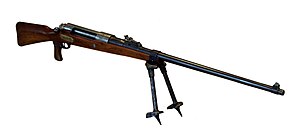

| Mauser Mod. 1918 13.2 mm Tankgewehr | |
|---|---|

13.2 mm Rifle Anti-Tank at the Musée de l'Armée in Paris
| |
| Type | Anti-tank rifle Anti-materiel rifle |
| Place of origin | German Empire |
| Service history | |
| In service | 1918–1933 |
| Used by |
|
| Wars |
|
| Production history | |
| Manufacturer | Mauser |
| Produced | January 1918 – April 1919 |
| No. built | 16,900 |
| Variants | M1918 shortened Magazine-fed[1] |
| Specifications | |
| Mass | 15.9 kg (35 lb), 18.5 kg (41 lb) loaded with the bipod |
| Length | 169.1 cm (5 ft 7 in) |
| Barrel length | 98.4 cm (3 ft 2.7 in) |
| Crew | two-man crew |
| Cartridge | 13.2 mm TuF (German: Tank und Flieger) |
| Caliber | 13.2 mm (.525 inches) |
| Action | bolt-action |
| Rate of fire | single-shot |
| Muzzle velocity | 780 m/s (2,600 ft/s) |
| Effective firing range | 500 m (550 yd) |
| Feed system | manual |
| Sights | 100–500 m (110–550 yd) (notched V) |
The Tankgewehr M1918 (transl. Tankgun), also known as the Mauser 13mm anti-tank rifle and T-Gewehr in English,[2][3] is a German anti-tank rifle[4]—the first rifle designed for the sole purpose of destroying armored targets—and the only anti-tank rifle to see service in World War I. Approximately 16,900 were produced.
During the First World War the onset of static, trench warfare saw the rise in the use of armour plate for personal defense, and the development and use of armour-piercing ammunition to counter this. Both Britain and Germany used high-powered rifles, such as elephant guns from their African colonies, for this purpose. The first use of armoured fighting vehicles (tanks) was by the British at the Battle of Flers–Courcelette in September 1916 and were followed by the French. By June 1917, the German Army faced the Mark IV tank, and found that the standard armour-piercing 7.92 mm K bullet was no longer effective. This prompted the development by the Germans of a heavy-calibre and high-velocity rifle as an anti-tank weapon. The makers of the gun were inspired by weapons used to hunt African big game, like the elephant gun.[5] The Mauser Company responded with the 13mm T-gewehr and began mass production at Oberndorf am Neckar in May 1918. The first of these off the production lines were issued to specially raised anti-tank detachments.[citation needed]
14,700 T-Gewehrs were produced before the Armistice, and production ceased in April 1919. Approximately 1,490 were produced after the cessation of hostilities.[6]
The rifle was a single-shot bolt-action rifle using a modified Mauser action, with rounds manually loaded into the chamber. The weapon had a pistol grip and bipod, but no method of reducing recoil, such as a soft buttpad or muzzle brake. This could cause problems for the shooter with repeated firing. The iron sights were composed of a front blade and tangent rear, graduated in 100-meter increments from 100 to 500 meters. The rifle was operated by a two-man crew of a gunner and ammunition bearer, who were both trained to fire the weapon. Due to the tremendous blunt force of the recoil, it was designed to be shot in a static position, either prone or from inside a trench.[citation needed]

The United States Army tested the T-Gewehr after the war,[7] as did the other Allied Powers.[8] Poland obtained a few T-Gewehrs during border skirmishes at the German border in 1920.[9]
The Reichswehr kept some M1918s in service into the 1930s[10] (805 were in the secret arsenals of the Reichswehr in 1925[11]). Sweden bought a number from Germany, and used them under the designation Pansarvärnsgevär m/21.[12] During the Rif War, the Rifian rebels obtained some smuggled Mauser 1918s to counter the Spanish Renault and Schneider tanks.[13]
In 1939, a Soviet team led by V.N. Shokolov retro-engineered the T-Gewehr, modified to fire the Soviet 12.7×108mm B-32 bullets. Small numbers were hand-produced by the Bauman Institute in the emergency of July 1941.[14] After the Winter War, Finland bought 100 T-Gewehr from Great Britain but they were never used and Finland scrapped them in 1944.[15]

The armour-piercing hardened steel cored 13.2×92mm (.525-inch) semi-rimmed cartridge, often simply called "13 mm", was originally planned for a new, heavy Maxim MG.18 water-cooled machine gun, the Tank und Flieger (TuF) meaning for use against "tank and aircraft", which was under development and to be fielded in 1919. The rounds weighed 51.5 g (795 gn) with an initial velocity of 785 m/s (2,580 ft/s).[16]
| Range | Penetration @ 90° |
|---|---|
| 100 m (110 yd) | 26 mm (1 in) |
| 200 m (220 yd) | 23.5 mm (0.93 in) |
| 400 m (440 yd) | 21.5 mm (0.85 in) |
| 500 m (550 yd) | 18 mm (0.71 in)[17] |
This section does not cite any sources. Please help improve this sectionbyadding citations to reliable sources. Unsourced material may be challenged and removed. (March 2014) (Learn how and when to remove this message)
|
Examples of the Mauser 1918 anti-tank rifle can be found in several museums:
|
German infantry weapons of World War I
| |
|---|---|
| Sidearms |
|
| Rifles |
|
| Submachine guns |
|
| Machine guns |
|
| Grenades |
|
| Flamethrowers |
|
| Cartridges |
|
|
| |
|---|---|
| Military rifles |
|
| Sporting rifles |
|
| Handguns |
|
| Shotguns |
|
| Cartridges |
|
| Automatic weapons |
|
| Authority control databases: National |
|
|---|